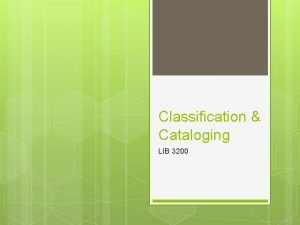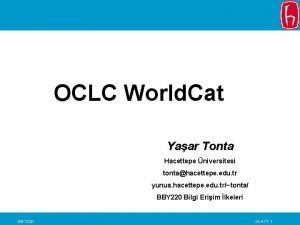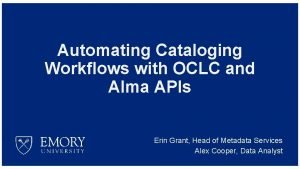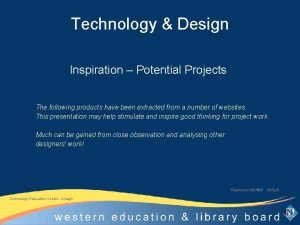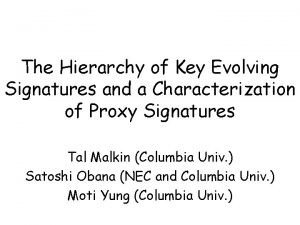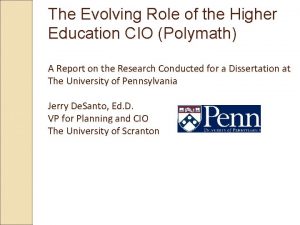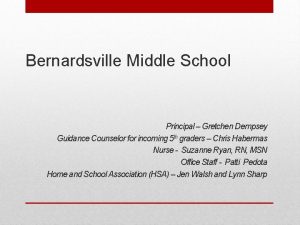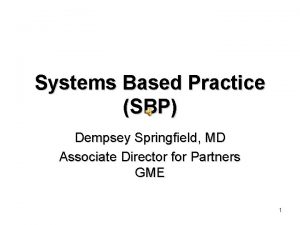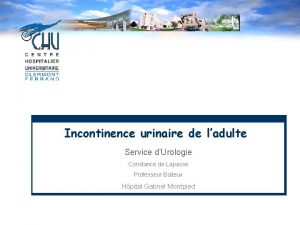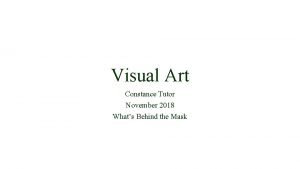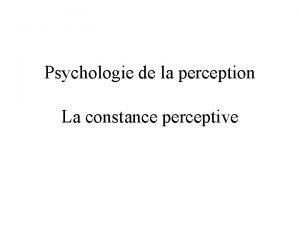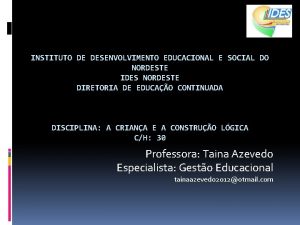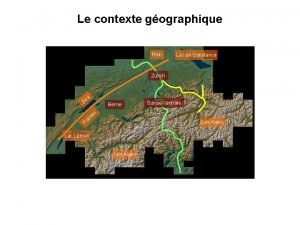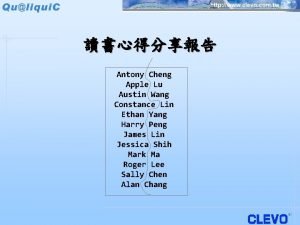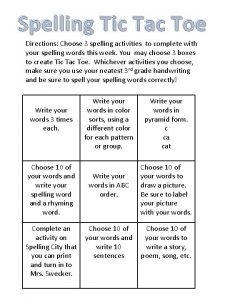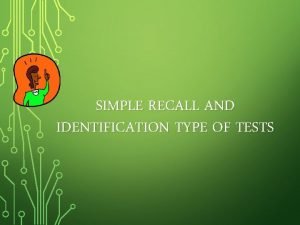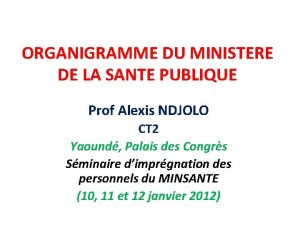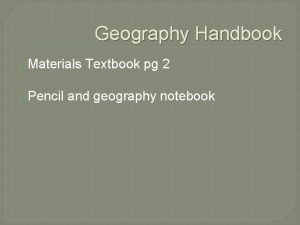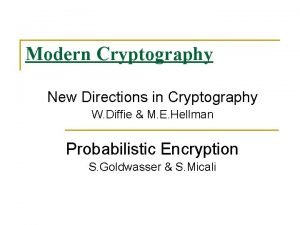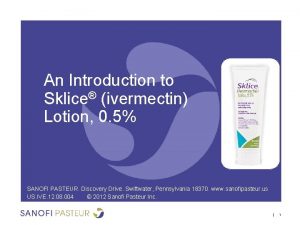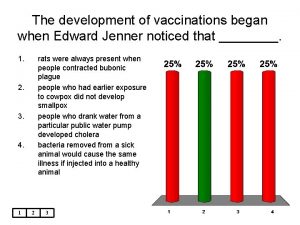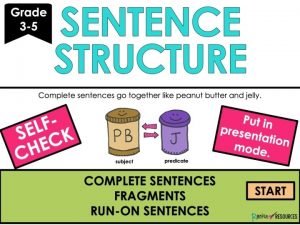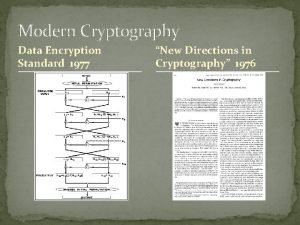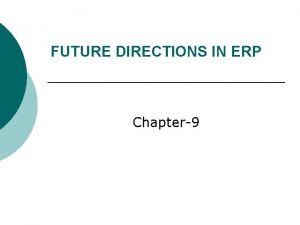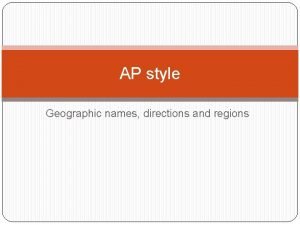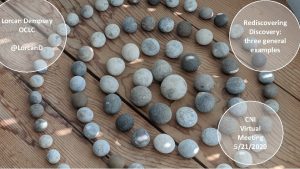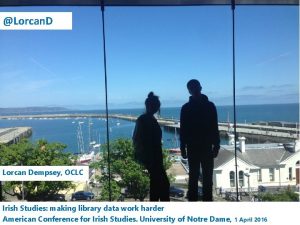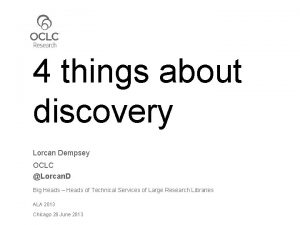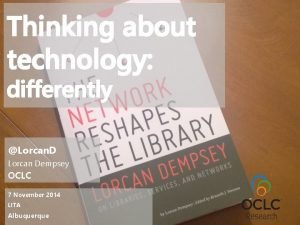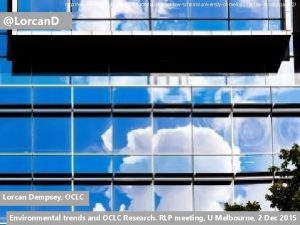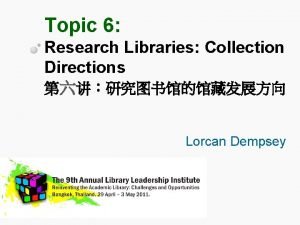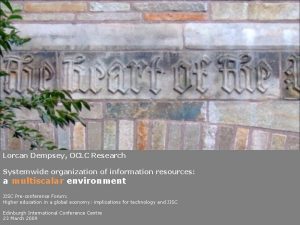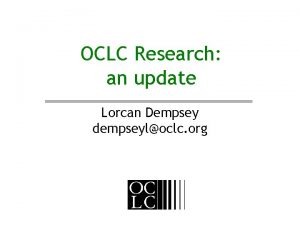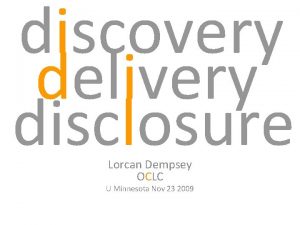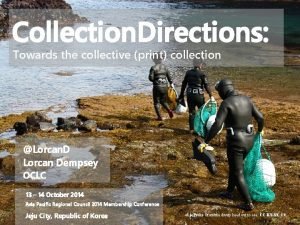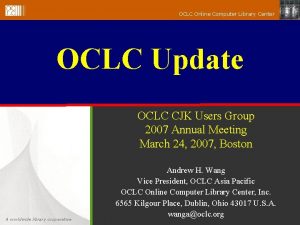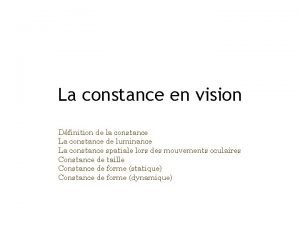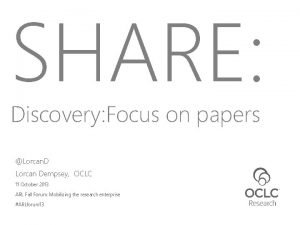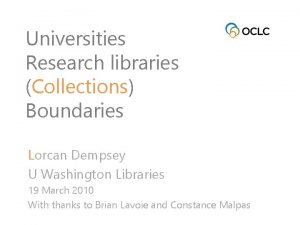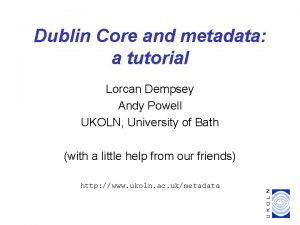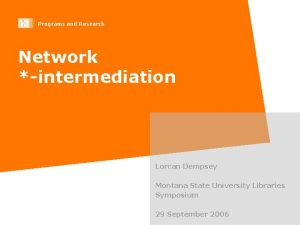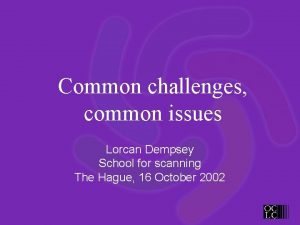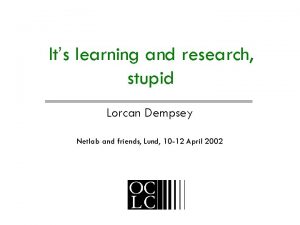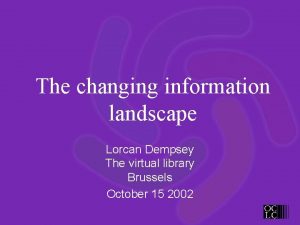Evolving Collection Directions Lorcan Dempsey Constance Malpas OCLC
















































- Slides: 48

Evolving Collection Directions Lorcan Dempsey & Constance Malpas OCLC @Lorcan. D @Constance. M Chicago, 30 Jan 2015 Collection Development Strategies in an Evolving Marketplace: an ALCTS Midwinter Symposium

Collection directions Overview

Collections 1 2 • The evolving scholarly record • Collection attention: collections grid Trends • Inside-out collections • Collections as a service • From curation to creation • Workflow is the new content 3 Towards the collective (print) collection • How we will manage print collections … differently.

Collection directions The evolving scholarly record

Framing the Scholarly Record … Figure: Evolving Scholarly Record framework. OCLC Research, 2014

Figure: Evolving Scholarly Record framework, publishing venues. OCLC Research, 2014

Collection directions Grid: collection attention

Open Web Resources In many collections ‘Published’ materials Licensed Low Stewardship Research & Learning Materials Purchased In few collections Figure: OCLC Collections Grid. High Stewardship Special Collections Local Digitization OCLC Research, 2014

Monographs 1. 2. 3. 4. 5. Emergence of ‘e’ (platform) Shift to demand driven acquisition Digital corpora Disciplinary differences Growing difference between market-available and distinctive (e. g. area studies) 6. Managing down print - shared print Journals 1. Licensed materials are now the larger part of academic library budgets 2. Publishers looking to research workflow (Elsevier – Mendeley, Pure) 3. National science/research policy and open access 4. A part only of the scholarly record – data, etc.

Research and learning material 1. Evolving scholarly record: research data, eprints, . . 2. IR – role and content? 3. Research information management (profiles, outputs, …) 4. Support for digital scholarship 5. Support for open access publishing Special collections, archives, … 1. Release more value through digitization, exhibitions, … 2. Streamlining processing, production, … 3. Network level aggregation for scale and utility – DPLA, Europeana, Pacific Rim Digital Library,

http: //www. lib. uts. edu. au/uts-epress

http: //hub. hku. hk/cris/rp/rp 00697 Compare: Kenning Arlitsch “New knowledge work” http: //www. tandfonline. com/doi/pdf/10. 1080/01930826. 2014. 946778


Institutional Needs – Academic Libraries: Current situation vs. 5 years from now Key Trends? : • increased reliance on group provisioning of print and licensed content • more integration of freely available web -based content • special collections focus on institutional mission, reputation • growing attention to teaching/learning materials; limited library capacity Open Web Resources Purchased Materials Licensed EResources In many collections Licensed Purchased Low Stewardship Special Collections Local Digitization High Stewardship In few collections Research & Learning Materials Figure: Projected shift in institutional attention, academic libraries. OCLC Research, 2015.

Institutional Needs – Research Libraries: Current situation vs. 5 years from now Key Trends? : • strategic realignment around purchasing/licensing ‘collections as services’ • redirection of investment toward research support (inc ‘reputation management’) • emphasis on effective disclosure of distinctive assets: special collections, research data, expertise Open Web Resources In many collections Purchased Materials Licensed EResources Licensed Purchased Low Stewardship Special Collections Local Digitization High Stewardship In few collections Research & Learning Materials Figure: Projected shift in institutional attention, research libraries. OCLC Research, 2015

Collection directions Collections as a service

Catalog KB/Discovery Lib. Guides, etc Google, Research. Gate, etc … Separation of discovery and collection? : • Focus shifts from owned to facilitated (available)? • Focus shifts from collection to other services (creation, …)? • Systemwide thinking becomes stronger? Owned Licensed Available Global Figure: Discoverability redefines collection boundaries. OCLC Research, 2015.

The ‘owned’ collection The ‘facilitated’ collection The ‘borrowed’ collection The ‘demand-driven’ collection A collections spectrum The ‘licensed’ collection • Purchased and physically stored The ‘shared print’ collection • Pointing people at Google Scholar • Including freely available e-books in the catalog • Creating resource guides for web resources Figure: A collections spectrum. OCLC Research, 2015.

Collection directions Workflow is the new content

ar. Xiv, SSRN, Re. PEc, Pub. Med Central (disciplinary repositories that have become important discovery hubs); Google Scholar, Google Books, Amazon (ubiquitous discovery and fulfillment hubs); Mendeley, Research. Gate (services for social discovery and scholarly reputation management); Goodreads, Library. Thing (social description/reading sites); Wikipedia, Yahoo Answers, Khan Academy (hubs for open research, reference, and teaching materials). Galaxy. Zoo, Fig. Share, Open. Refine (data storage and manipulation tools) Github (software management)

http: //www. nature. com/news/online-collaborationscientists-and-the-social-network-1. 15711

http: //innoscholcomm. silk. co/

http: //innoscholcomm. silk. co/

Wouter Haak Elsevier, VP Product Strategy LIBER, Riga, 2014

A publisher’s new job description Annette Thomas, CEO of Macmillan Publishers Her view is that publishers are here to make the scientific research process more effective by helping them keep up to date, find colleagues, plan experiments, and then share their results. After they have published, the processes continues with gaining a reputation, obtaining funds, finding collaborators, and even finding a new job. What can we as publishers do to address some of scientists’ pain points? http: //www. against-the-grain. com/2012/11/a-publishers-new-job-description/




29


Workflow is the new content • In a print world, • In a digital world, the researchers and library needs to learners organized organize itself around their workflow around the workflows of the library. research and learners. • The library had limited • Workflows generate interaction with the full and consume information resources. process.

Collection directions The inside out collection

OCLC Collections Grid Library as broker Maximise efficiency Outside, in Then In many collections Licensed Market Low Stewardship A Purchased High Stewardship Distinctive Now Library as provider Maximise discoverability Inside, out In few collections Figure: OCLC Collections Grid, shift in emphasis. OCLC Research, 2014.

Collection directions From curation to creation

U Minnesota, ARL Institutional profile “In alignment with the University's strategic positioning, the University Libraries have re-conceived goals, shifting from a collection -centric focus to one that is engagement-based. ” http: //umcf. umn. edu/awards/2006/images/margo_library_lg. jpg http: //www. libqual. org/documents/admin/Profiles_apndx_C. pdf

Transformation of the academic library Kurt de Belder http: //www. oclc. org/content/dam/research/events/dss/ppt/dss_debelder. pptx 36

http: //accessceramics. org/

Collection directions Towards the collective (print) collection

The bubble of growth in twentieth- century printed collections has left … librarians with a tricky problem. Barbara Fister New Roles for the Road Ahead: Essays commissioned for ACRL’s 75 th Birthday

http: //www. slideshare. net/malbooth/uts-future-library-more-than-spaces-technology Mal Booth, UTS Library

Shared Print • ‘Rightscaling’ management of print resources, part of larger shift to above-the-institution solutions • Opportunity costs of maintaining institution-scale operations are very high – acknowledging deep reluctance to managing down local inventory • Early efforts focused on journals (because risks are low; scholarly attention has moved on); new groundswell of activity around monographs • Strategic goal – increase operational efficiencies for managing print so that library resources can be redirected to distinctive collections and services 41

Shared print- collective collection Then: Value relates to depth and breadth of local collection. Now: Value relates to systemwide curation of and access to print collections – ‘rightscaling’. Decision support through shared data. 42

North American print book resource: 45. 7 million distinct publications 889. 5 million total library holdings Figure: North American Regional Print Book Collections. OCLC Research, 2013.

Mega-regions & Shared Print Initiatives Orbis. Cascade MSCS OCUL WEST CIC WRLC SCELC GWLA ASERL FLARE We expect that in 5 -7 years the larger part of the North American ‘collective collection’ will have moved into shared management. Figure: North American Mega-regions and shared print activity. Research, 2013. OCLC Research, 2013

Collection directions In conclusion

Then: the user in the life of the library Now: the library in the life of the user The practice of research and learning is changing. Research and learning outputs are diversifying. Research outputs are the subject of policy attention Publishers supporting workflow and reputation. Move to facilitated access to require materials – collection as a service. Move to management and disclosure of institutional materials – inside out. The print and digital scholarly record needs conscious coordination at the network level.

@Lorcan. D http: //www. oclc. org/research

Credits This presentation reflects ongoing shared work with our colleague Brian Lavoie. Thanks to our colleague JD Shipengrover for graphics. • The Evolving Scholarly Record http: //oclc. org/content/dam/research/publications/library/2014/oclcresearch-evolving-scholarlyrecord-2014. pdf • Understanding the Collective Collection http: //oclc. org/research/publications/library/2013 -09 r. html • Collection Directions http: //www. oclc. org/content/dam/research/publications/library/2014/oclcresearch-collectiondirections-preprint-2014. pdf 48
 Constance malpas
Constance malpas Lorcan martin
Lorcan martin Oclc worldshare management services
Oclc worldshare management services Classify.oclc.org
Classify.oclc.org Oclc
Oclc Oclc api
Oclc api Oclc classify
Oclc classify Evolving design
Evolving design A framework for clustering evolving data streams
A framework for clustering evolving data streams Key evolving signature
Key evolving signature Evolving
Evolving Paul stephen dempsey
Paul stephen dempsey Bedwell middle school
Bedwell middle school Dempsey travel trim
Dempsey travel trim Moore v dempsey oyez
Moore v dempsey oyez Dempsey springfield
Dempsey springfield Josh dempsey shot
Josh dempsey shot Manœuvre de bonney
Manœuvre de bonney Constance lloyd
Constance lloyd Gia hill sister
Gia hill sister Constance slides carnival
Constance slides carnival Constance lloyd
Constance lloyd Why be happy when you could be normal
Why be happy when you could be normal Constance de forme
Constance de forme Constance kamii biografia
Constance kamii biografia Zurich constance
Zurich constance Constance lloyd
Constance lloyd Applelu
Applelu Landsat collection 1 vs collection 2
Landsat collection 1 vs collection 2 Documentary collection
Documentary collection Signal words for sequence
Signal words for sequence Body planes directions and cavities
Body planes directions and cavities May spelling tic tac toe
May spelling tic tac toe Who is the father of social psychology
Who is the father of social psychology What is identification test
What is identification test Organigramme ministère santé
Organigramme ministère santé Cardinal directions
Cardinal directions 1976 new directions in cryptology
1976 new directions in cryptology Sklice instructions
Sklice instructions Directions
Directions A vaccination for smallpox was developed in 1796 by ____
A vaccination for smallpox was developed in 1796 by ____ Short answer directions
Short answer directions Directions complete the sentences
Directions complete the sentences Does everything fall at the same speed
Does everything fall at the same speed Which blow steadily toward the equator?
Which blow steadily toward the equator? New directions in cryptography
New directions in cryptography Future directions of erp
Future directions of erp Western ap style
Western ap style Move rulesz
Move rulesz



